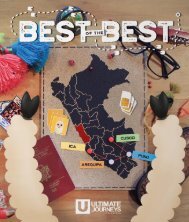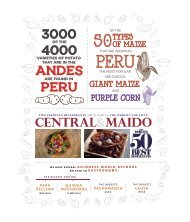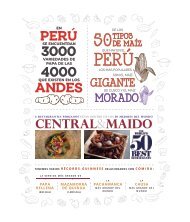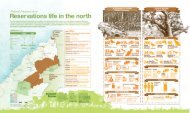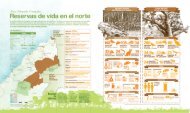UJ #14 - Qhapac Ñan
You also want an ePaper? Increase the reach of your titles
YUMPU automatically turns print PDFs into web optimized ePapers that Google loves.
Archaeologists working with the residents on the zoning<br />
of the land crossed by the Qhapaq <strong>Ñan</strong>.<br />
is not possible to progress, as they also have to<br />
meet their needs. We cannot sell culture alone,<br />
there has to be a benefit for the population,”<br />
commented Luis Enrique Paredes, Director of the<br />
Huanuco Pampa Comprehensive Project.<br />
INCLUSIVE<br />
HERITAGE<br />
“Heritage belongs to all.” Indeed, both the local<br />
population and the visitors have the opportunity<br />
of enjoying wonderful destinations such as Machu<br />
Picchu or the Qhapaq <strong>Ñan</strong> in Peru. However, the<br />
accessibility of some places is limited by their<br />
geographic location or by the lack of an appropriate<br />
infrastructure.<br />
Qhapaq <strong>Ñan</strong> Project’s National Office<br />
According to the results of the First National<br />
Specialized Survey on Disability conducted by the<br />
National Council for the Integration of People with<br />
Disabilities (CONADIS) published in 2016, Peru<br />
has 1,575,402 people with some type of disability<br />
who account for 5.2% of the total population. It is<br />
important to generate inclusive tourism programs<br />
for people that enable them to have an equitable<br />
approach to culture.<br />
In the cities or in remote towns, the Community<br />
Involvement area is carrying out actions to integrate<br />
people with disabilities to culture and tourism.<br />
Working with associations of blind and deaf people,<br />
they obtain first-hand information on their needs to<br />
prepare a project that fits out certain archaeological<br />
centers to be visited this group of the population.<br />
Another way of achieving inclusion when working<br />
with Andean communities is to hold meetings with<br />
them in their mother tongue, either Quechua or<br />
Aymara. By approaching them with this assertive<br />
instruction, the communication becomes more<br />
effective, enhancing the diversity of languages<br />
spoken in our country.<br />
“The Qhapaq <strong>Ñan</strong> is becoming a symbol of unity,<br />
of the convergence of people, the interrelation<br />
with the Tahuantinsuyo of the past and today’s<br />
populations. It represents the link of an entire<br />
country,” said Ruiz. As legacy that connected an<br />
empire and has the potential to connect a nation<br />
and make it feel proud of its past.<br />
The new<br />
generations<br />
learn the<br />
importance of<br />
their cultural<br />
legacy since<br />
their childhood.<br />
Sergio Salazar<br />
69




